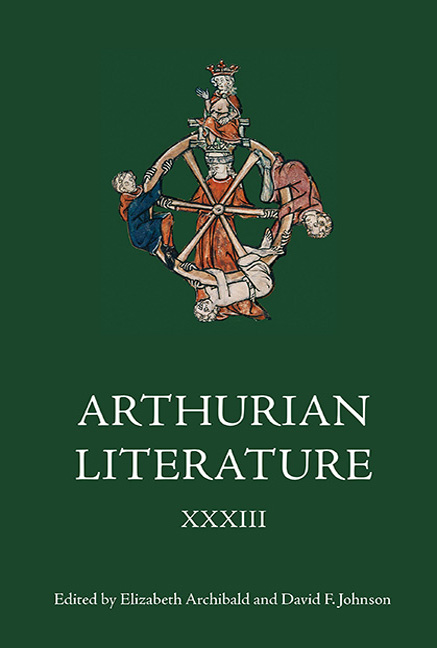Book contents
- Frontmatter
- Contents
- General Editors’ Foreword
- Contributors
- I From ‘The Matter of Britain’ to ‘The Matter of Rome’: Latin Literary Culture and the Reception of Geoffrey of Monmouth in Wales
- II ChrÉtien's British Yvain in England and Wales
- III Edward III's Abandoned Order of the Round Table Revisited: Political Arthurianism after Poitiers
- IV ‘Thanked Be God There Hath Been But A Few Of Myne Auncytours That Hathe Dyed In Their Beddes’: Border Stories and Northern Arthurian Romances
- V T. H. White's Representation of Malory's Camelot
- VI The Old Knight An Edition of the Greek Arthurian Poem of Vat. Gr. 1822
- Miscellaneous Endmatter
- Commentary
- Contents of Previous Volumes
V - T. H. White's Representation of Malory's Camelot
Published online by Cambridge University Press: 29 July 2017
- Frontmatter
- Contents
- General Editors’ Foreword
- Contributors
- I From ‘The Matter of Britain’ to ‘The Matter of Rome’: Latin Literary Culture and the Reception of Geoffrey of Monmouth in Wales
- II ChrÉtien's British Yvain in England and Wales
- III Edward III's Abandoned Order of the Round Table Revisited: Political Arthurianism after Poitiers
- IV ‘Thanked Be God There Hath Been But A Few Of Myne Auncytours That Hathe Dyed In Their Beddes’: Border Stories and Northern Arthurian Romances
- V T. H. White's Representation of Malory's Camelot
- VI The Old Knight An Edition of the Greek Arthurian Poem of Vat. Gr. 1822
- Miscellaneous Endmatter
- Commentary
- Contents of Previous Volumes
Summary
Generations of readers have been introduced to the work of Sir Thomas Malory through T. H. White's The Once and Future King. White's Arthurian epic unreservedly praises Malory's art and has been called a ‘homage to Malory’. The novel refers to Malory by name several times, frequently in reverential, if not laudatory, terms: ‘if you want to read about the beginning of the Quest for the Grail, about the wonders of Galahad's arrival … you must seek them in Malory … that way of telling the story can only be done once’ (p. 459). Elsewhere, the text again defers to Malory, and even offers a defence of a potential criticism: ‘if people want to read about the Corbin tournament, Malory has it … he was a passionate follower of tournaments … the only things which are apt to be dull in Malory are the detailed score-sheets [of the tournaments] … and even they are not dull for anybody who knows the form of the various smaller knights’ (pp. 489–90). In personal correspondence, White's admiration for Malory's literary technique is ebullient; for example, in a letter to L. J. Potts, he writes ‘Guenever is one of the realest women in literature … read her intense scene with Elaine, just after they have driven Lancelot mad … it is a great piece of feeling and dignity to both sides … what a wonderful man Malory was, to do the Dostoievsky [sic] in four or five sentences, instead of taking a hundred thousand words for it.’ In another letter to David Garnett, White characterizes his own intent rather modestly: ‘I never pretended to be more than a footnote to Mallory [sic].’ Other statements by White express the same degree of self-modesty and reverence for Malory: in her study of his novel, Elisabeth Brewer notes that in White's journal he mentions that he intended to write an introduction to his book to the effect that ‘these books are only a marginal embroidery upon the immortal work of Sir Thomas Malory’. The introduction was apparently never published.
White's novel probes Malory's text to a sophisticated level of depth. The characterizations of Gawaine, Lancelot and Guenevere, for example, emphasize nuances found in Malory, but to a greater degree, as Brewer notes:
- Type
- Chapter
- Information
- Arthurian Literature XXXIII , pp. 140 - 157Publisher: Boydell & BrewerPrint publication year: 2016

